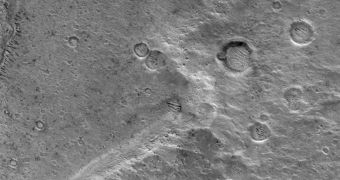Using its High Resolution Imaging Science Experiment (HiRISE) camera, the NASA Mars Reconnaissance Orbiter (MRO) has recently snapped some amazing photos of unique features on the surface of the Red Planet, fluidized-ejecta craters (also known as rampart craters). The geological formations, which result from comet, asteroid, or meteorite impacts, are somewhat unique in the solar system, in that they cannot be seen on Earth or Mercury, experts at the NASA Jet Propulsion Laboratory report. The JPL is based at Caltech, in Pasadena, California.
Recent craters on the Moon or Mercury are also a sight to behold, with their ejecta blankets looking a bit rough near the crater rims. This applies mostly to the smaller ones. When it comes to large craters, a myriad of smaller ones can be seen all around, forming rays of secondary impact sites. Because they were created through the action of the Laws of Physics, these craters can also be seen on Mars. But the Red Planet also boasts another type of craters, known as rampart craters, which have rounded, or lobate, ejecta blankets.
These peculiar formations end in low ridges or ramparts, as seen in plain view. The recent MRO image shows such a structure on the Red Planet, generated by a crater with a diameter of about 16 kilometers, or roughly ten miles. The original impact site is located another ten miles to the East, but the photograph surprises both structures flawlessly. In addition to providing geologists with study materials, the new craters also generated a heated debate in the scientific community when they first appeared. Some believed that their shapes were determined by their interaction with the thin Martian atmosphere, whereas others said that volatile compounds such as water were essential to their appearance.
The largest number of scientists eventually concluded that the second hypothesis was the most plausible, and, as such, the craters are now used as evidence to indicate that the planet had a wet history not very long ago. The most recent evidence of liquid water on the Red Planet dates from around one billion years ago, previous studies have shown. The new image may also be added to the growing body of pieces of evidence showing the planet's unfortunate faith, which made it lose its surface water in favor of two polar ice sheets. The August 23 photo is available here, alongside other images from the same region.

 14 DAY TRIAL //
14 DAY TRIAL //